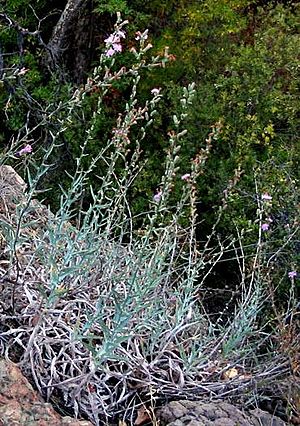Stephanomeria cichoriacea facts for kids
Quick facts for kids Stephanomeria cichoriacea |
|
|---|---|
 |
|
| Scientific classification | |
| Kingdom: | |
| (unranked): | |
| (unranked): | |
| (unranked): | |
| Order: | |
| Family: | |
| Tribe: |
Cichorieae
|
| Subtribe: |
Microseridinae
|
| Genus: |
Stephanomeria
|
| Species: |
S. cichoriacea
|
| Binomial name | |
| Stephanomeria cichoriacea |
|
The chicoryleaf wirelettuce (scientific name: Stephanomeria cichoriacea) is a cool flowering plant. It's part of the aster family, which includes sunflowers and daisies. This plant is also sometimes called the silver rock-lettuce. It's a special plant because it only grows in one place in the world: California!
Where It Lives
The chicoryleaf wirelettuce is a native plant of California. This means it's endemic to that state. You can find it growing in the coastal mountains. It lives as far north as Monterey County. However, it's most common in the mountains of southern California. This includes places like the Transverse Ranges.
Its favorite place to grow is in areas called chaparral. Chaparral is a type of shrubland habitat. It has tough, woody shrubs and dry summers.
What It Looks Like
The chicoryleaf wirelettuce is a perennial herb. This means it's a plant that lives for more than two years. It grows new stems each year. Its stems are thin and stand up straight. They can grow quite tall, sometimes over one meter (about 3 feet) high!
The stems feel a bit fuzzy or "woolly." This is especially true when they are new and young. Most of the plant's leaves grow in a circle near the ground. This is called a basal rosette. These larger leaves can be up to 18 to 20 centimeters (about 7 to 8 inches) long. They are shaped like a spear and often have jagged edges. The newer leaves are also woolly. Smaller leaves can be found higher up on the stem.
Flowers and Seeds
The plant produces many flower heads. These grow in a long cluster called an inflorescence. Some flower heads also appear where the upper leaves meet the stem. Each flower head has a tube-shaped base. This base is about 1 to 2 centimeters long. It's covered with layers of special leaves called phyllaries. These phyllaries are a bit sticky or "glandular."
Each flower head has 10 to 15 pink flowers. These are called ray florets. Each floret has a long tube and a pink, strap-like part. This pink part can be up to 2 centimeters long. After the flowers bloom, they produce fruit. The fruit is a small, dry seed called an achene. Each achene has a fluffy top. This top is made of long, feathery bristles. These bristles help the seeds float away in the wind.

